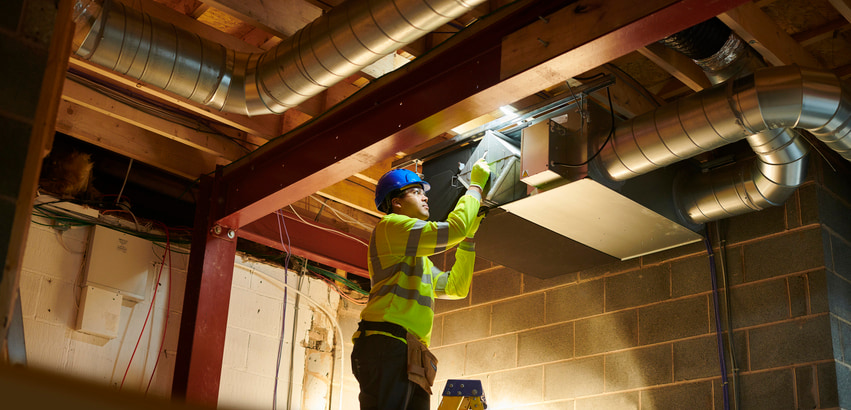
Enhancing Indoor Air Quality in Commercial Buildings
November 6, 2025
Breathing is something we do every moment without thinking, but the quality of the air inside your commercial building can have a huge impact on the health, comfort, and productivity of everyone who works there. Dust, allergens, mold, and even chemical pollutants can accumulate over time, quietly affecting employees and visitors alike.
For business owners and facility managers, ensuring clean, healthy air isn’t just about compliance or maintenance; it’s about creating an environment where people can thrive. From HVAC system upgrades to simple ventilation improvements, there are practical steps that any commercial facility can take to enhance indoor air quality, improve workplace satisfaction, and support long-term operational efficiency.
Why Indoor Air Quality Matters
Poor indoor air quality can lead to:
- Respiratory issues like allergies or asthma flare-ups
- Fatigue, headaches, and reduced concentration
- Increased sick days and reduced productivity
- Accelerated wear on equipment due to dust and particulate accumulation
Healthy air isn’t just a comfort issue; it’s a business issue. Facilities that prioritize clean, well-ventilated spaces see tangible benefits in employee performance and operational efficiency.
Step 1: Maintain HVAC Systems Regularly
Your HVAC system is the backbone of your building’s air quality. Regular maintenance ensures it’s running efficiently and effectively. Key practices include:
- Replacing air filters on schedule (typically every 1–3 months, depending on usage)
- Inspecting ductwork for leaks or blockages
- Cleaning coils, vents, and condensate drains to prevent mold growth
- Scheduling professional HVAC inspections at least twice a year
For facilities in Connecticut and across the Northeast, local service providers can help ensure your HVAC systems meet regional climate demands and regulatory standards.
Step 2: Improve Ventilation and Airflow
Even the cleanest air filters can’t compensate for poor airflow. Proper ventilation helps dilute indoor pollutants and maintain a comfortable environment. Consider:
- Introducing more outdoor air through vents or windows when weather permits
- Using energy-efficient fans to circulate air in larger spaces
- Installing advanced air handling units or air exchangers in high-traffic areas
- Ensuring that furniture or storage doesn’t block vents
Balanced airflow can reduce stagnant air pockets where dust and allergens accumulate, creating a healthier environment for employees and visitors alike.
Step 3: Monitor and Reduce Indoor Pollutants
Indoor pollutants come from a variety of sources: cleaning products, office equipment, construction materials, and even furnishings. Effective strategies include:
- Using low-VOC (volatile organic compound) paints, adhesives, and furnishings
- Reducing the use of harsh cleaning chemicals and opting for eco-friendly alternatives
- Regularly cleaning carpets, curtains, and upholstered furniture to limit dust buildup
- Monitoring CO₂ and humidity levels to prevent mold and bacterial growth
Technology like air quality monitors can help facility managers track pollutant levels and make data-driven decisions to improve air quality.
Step 4: Introduce Green Practices
Green building practices not only reduce environmental impact but also improve IAQ:
- Incorporate indoor plants that naturally filter air
- Utilize sustainable materials for renovations and maintenance projects
- Encourage recycling and proper disposal of office supplies to minimize dust and waste
- Implement energy-efficient systems that also improve ventilation
Adopting green initiatives can also enhance corporate reputation and align with growing regulatory expectations.
Step 5: Engage Employees and Tenants
A successful IAQ program is a collaborative effort. Encourage staff and tenants to participate by:
- Educating teams about proper ventilation practices
- Posting reminders to keep vents unblocked and report air quality concerns
- Encouraging clean desk and workspace habits
- Soliciting feedback to identify areas for improvement
Creating awareness helps ensure long-term success and builds a workplace culture that values health and sustainability.
Take Action with Expert Facility Management
Improving indoor air quality doesn’t have to be overwhelming. With a proactive plan, the right tools, and the right partners, you can create a safer, healthier, and more productive environment.
At ONE SOURCE Companies, we help businesses across Wallingford, CT, and the Northeast optimize their facilities for efficiency, safety, and sustainability. From HVAC maintenance and ventilation planning to pollutant monitoring and green initiatives, our expert team provides tailored solutions that meet the unique needs of your facility.
📞 Call us today or visit our site to learn how we can help enhance indoor air quality in your commercial building and keep your operations running smoothly.
Recent News

Implementing Zero-Waste Initiatives in Facility Operations
August 6, 2025

The Ultimate Guide to Facility Management for New Business Owners
May 6, 2025

Spring Readiness: Essential Facility Maintenance Checklist
April 7, 2025

Maximizing Space Utilization in Commercial Properties
February 12, 2025

Keeping Your Commercial Building Healthy: Why Duct Cleaning Matters This Flu Season
January 14, 2025

Free Budget Planning Strategies for Facility Management Cost Control
November 8, 2024


